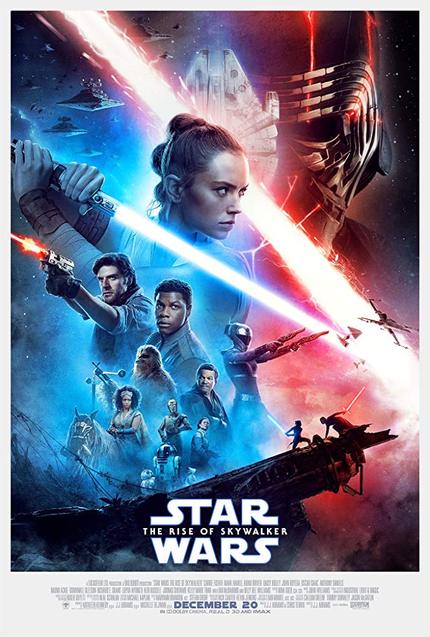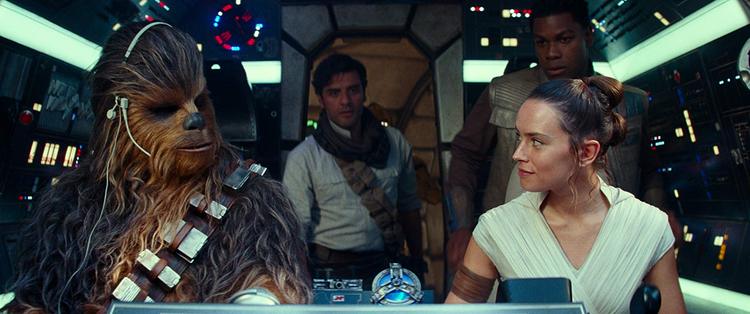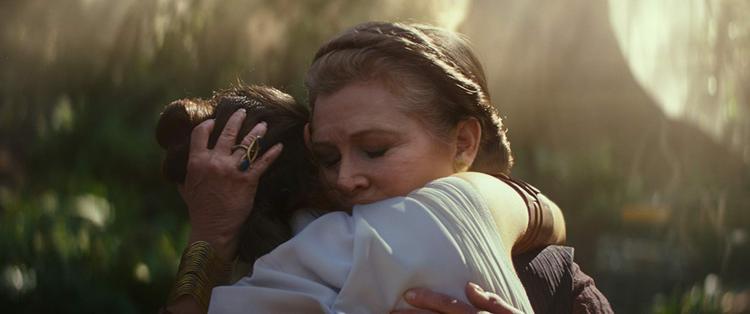Review: STAR WARS: THE RISE OF SKYWALKER Is Mired in the Past
J.J. Abrams returns to direct Adam Driver, Mark Hamill, Carrie Fisher, Oscar Issac and Daisy Ridley.

It’s been said that J.J. Abrams makes movies for the shareholders. If that’s the case, welcome to the board meeting to end all board meetings. No one ever said that pleasing everyone would be easy, but with The Rise of Skywalker, the director pretty much nails it. That is to say, this film --much ballyhooed as the Final Chapter in the nine-part, forty-two-year-running “Skywalker Saga” -- is, aside from everything else and the kitchen sink, an entirely, deliberately, innocuously, agreeable film.
As the galaxy reels from the realization that the thought-dead shriveled and perpetually cackling Sith Lord, Emperor Palpatine (Ian McDiarmid), is back and up to his old tricks, the chronically displaced heroine Rey (Daisy Ridley) is deep into her Jedi training on a new woodsy obstacle course planet. Kylo Ren (the great Adam Driver), the new Supreme Leader of the First Order and evil son of Han Solo and Leia Organa, has set about looking for Palpatine, all the while also looking to continue his Dark Side seduction of Rey. In the course of Disney’s Star Wars “sequel trilogy”, the downright weird relationship of these two characters has taken center stage. It all comes to a glowing, lightsaber-clashing head with The Rise of Skywalker, with both Ridley and Driver giving this resolution their devoted all.
Also back is the rest of the crew: Oscar Isaac as the brash but heroic Poe Dameron, John Boyega as the former stormtrooper Finn, Joonas Suotamo as Chewbacca, and Anthony Daniels as C-3PO (finally given a purpose for his presence in these latter day Star Wars films). Fan favorite Lando Calrissian (Billy Dee Williams) finally wanders back into the series, as does the strange and unfulfilled character of Maz Kanata (a wasted Lupita Nyong’o). The core group pulls together in the Millennium Falcon for the first time (on film) in order to take on the newly uncovered threat of Palpatine (a.k.a. Darth Sidious).
One would think that with a legacy villain like that in tow, The Rise of Skywalker wouldn’t have a villain problem. And yet, with Palpatine quarantined to his oppressively eerie subterranean lair, and Kylo Ren off on personal business with his largely unexplained Knights of Ren, the role of active baddie falls upon under-utilized yet very welcome newcomer, Richard E. Grant as the hissable Allegiant General Pryde. Pryde, along with returning bombastic third-wheel General Hux (Domhnall Gleeson) is tasked with commanding a sky full of impressively mighty copy/pasted Star Destroyers, each one outfitted with a new incredibly deadly weapon. The good guys must figure out a way to stop all of this. Everyone has their own respective arcs, some more weighty and/or interesting than others. But that’s basically the galactic gist of it.
Gone is the murky ambivalence and formal challenges of Rian Johnson’s intelligent but sprawling The Last Jedi. Hyper-focused not only on tying up the myriad of dangling threads over-seeded in the previous two films (2015’s The Force Awakens and 2017’s The Last Jedi), but also burdening itself with wrapping up the entire history of the Skywalker-centric episodes (which takes us back to 1977’s original Star Wars, now referred to as A New Hope), this production does indeed nearly choke on its aspirations.
With The Force Awakens, director Abrams was tasked with a job even more impossible than what he’s attempting with this movie. His job then was to make Episode VII a Star Wars that re-ignited the half-dormant and damaged franchise, setting it on course for viability and financial solvency for decades to come. Inso, he was also charged with returning the series to its roots. Thanks to precise marketing, a calculated use of nostalgia, and new character that cross the bar of being interesting enough to go forward with, audiences the world over joined Han in the pronouncement, “Chewie, we’re home.”
But that film is also scattered and fundamentally retrograde, planting enough unexplained story seed for twenty-two episodes of television when in reality, it was always known that this would be a three-part trilogy. Johnson’s brazen curtailing (the death of Snoke, the reveal that Rey’s parents were “no one”) of some of what he viewed as less interesting aspects of The Force Awakens’ carpet-bombing of Star Wars-esque things angered many, as did his re-introduction of Luke Skywalker as an angry old man in self-imposed exile. Yet, there’s more care, intelligence, narrative boldness, and spark for the future in that Star Wars film than in either of Abrams’s. Abrams, at the end of the day, is passionate about one thing: old Star Wars. His The Rise of Skywalker, at best, is to Return of the Jedi what Johnson’s The Last Jedi is to The Empire Strikes Back.
There’s no shortage to those of us who claim lifelong alliance to the Star Wars franchise. The most engaged continue to love Star Wars for its possibilities, not for its predictability. (Predictability isn’t always a bad thing, but… it’s been done). Consequently, if this supposed finale is going to let down any single group, it might as well be the notoriously hard-to-please first-generation Star Wars fans. After all, one way or another, we’ve all been down that road of galactic disappointment at one time or another. We might complain loudly, but we’ll keep coming back. Our children and their children, though, simply by virtue of the stuff that happens in the Skywalker story, might read Episode IX’s grandiose dose of inevitably as something entirely appropriate, even fully satisfying.
We old guys will tell you that we know the deal. (Whether you ask to hear it or not). “The end of Star Wars”... we’ve been faced with this two other times in our lifetime. The first was 1983’s Return of the Jedi, when an exhausted George Lucas declared that movie to be the quick end to the would-be nine-(No, twelve! No, six!)-part saga. In 2005, with Revenge of the Sith, when Lucas again declared the saga complete, we again made emotional amends with this series drawing to a close. Here we are again, at yet another declared finish line. Forgive us if we can’t quite get as emotionally convinced of the finality as willingly cross it. (Place your bets now for how far into the future Episodes X through XII will be announced).
That said, it’s likely safe to say that certain elements that have always been considered “core Star Wars”- in particular, various legacy characters, as well as the music of John Williams- are now done. For them, in an of themselves, the send-off is generally decent. Williams in particular, as always, gives this his all, truly treating his soundtrack like the all-inclusive final movement of a major nine-part symphony; grand and monumental in ways that the film itself doesn’t always deserve. (Something not unlike certain other Star Wars films) In a career chock-full of iconic cinema music, Williams’s nine-part Star Wars score will be remembered as his greatest masterpiece. If anyone has ever truly “gotten” Star Wars and unabashedly embraced it at every phase of its varied history, it’s John Williams. He’s already got more Oscar nominations than anyone else; give this man a medal.
Rise of Skywalker moves fast enough so that you might not notice that certain seams are visible. The most glaring of such is the presence of Carrie Fisher as General Leia Organa. While it’s true that the character deserves a proper send-off, the lingering presence of an actress who died in 2016 is, at this point, ever-so-slightly, undeniably ghoulish. Every Leia moment is obviously reverse engineered from previously shot, unused footage. The handful of Leia moments that do not originate that way are even more clumsy, with the character off-screen, out of focus, or standing in shadows.
The untimely death of Fisher is, of course, quite the conundrum for the series, with full sympathy continuing to go to her family and friends, and an understanding of what a tough spot Lucasfilm found itself in, as Episode IX was supposed to be “the Leia episode“. Perhaps there was no right answer to this one. And perhaps 2017’s The Last Jedi would’ve been too soon to have the character die on screen. But this clunky bit of retrofitting isn’t doing Fisher’s legacy, nor Star Wars, any favors.
Meanwhile, the film’s obligatory new characters are once again female, but unlike The Last Jedi’s Admiral Holdo (Laura Dern) and Rose Tico (a returning Kelly Marie Tran, given nothing to do), both of whom have been unduly targeted by certain bullying fans, the more Barbie-built Zorii Bliss (Keri Russell) and Jannah (Naomi Ackie) are both more action figure-centric and the type of heroine that such shallow fanboys wouldn’t mind seeing around Galaxy’s Edge. This is still the J.J. Abrams who, in the film he made right before The Force Awakens, stripped actress Alice Eve down to her undies just to serve up a cheap thrill. For all the reforging of Star Wars in terms of character diversity, which he gets credited with (actually, look into the Lucasfilm story group, and beyond, for the likely true credit), Abrams is still a conventional showman, bound by very conventional expectations. You show me the latest J.J. Abrams “puzzle box” marketing (is that still a thing?), and I’ll show you a movie that’s predictable at every turn.
While this film on the whole is happy to condescend to the child in all of us, it may be a bit too eager to wallow too long in its own manufactured intensity. Visually, this is the ugliest Star Wars film short of the unjustifiably inky Solo: A Star Wars Story. Abrams, going for a shorthand of dread, has imbued his film with a murky blue palate that only eases off intermittently to deliver the occasional and all-too-fleeting beautifully rendered image. The film’s heavy insistence on close-ups threatens its epic scope, often generating an unintentional claustrophobic aesthetic. Despite the abundance of final-bow moments taken by the likes of Mark Hamill and Carrie Fisher, the galaxy feels somehow less familiar insomuch as an apparent aesthetic rush-job has resulted in ships flying around in tepid space stew.
This space stew may be tepid but it’s also over-flavored, and like Return of the Jedi before it, all too happy to be served up and done. And like that one, The Rise of Skywalker is a tired movie, though caboosing a saga that is so many more years on and with considerable baggage to sort out- and far more of it- it’s also struggling far more to stick the landing. But then, The Rise of Skywalker takes us nowhere new that the myriad of post-Star Wars imitators to the throne haven’t by already raced to several times over. It’s an ending, yes- and not necessarily the altogether wrong ending. Nevertheless, following the Joseph Campbell-ian/Star Wars beats is all that it has time for.
George Lucas has never been shy about expressing that Star Wars is, fundamentally, for kids. From that point, it’s also for everyone. But at its core, it’s for kids. Crucially though, Star Wars, at its best, understands that being for kids doesn’t mean dumbing things down, or easing off of appropriate fright. The Rise of Skywalker is scary from the get-go, taking us into a dread-inducing environment right out of a contemporary haunted house attraction (dark, foggy, flickering lights, creepy stuff, and so forth). The moment culminates with the heavily touted return of classic Star Wars essential baddie Emperor Palpatine, now shriveled with white eyes and on some sort of spooky space life support system. It’s fair warning to parents of young kids that this imagery is, by design, straight-up nightmare fuel.
Lingering in and dwelling on the past is exactly what Yoda chastises Luke for. Not only that, but attachment to the past and an unwillingness to naturally move on proved to be the Achilles heel of Luke’s father, Anakin. It’s good to want to take a moment to honor, even celebrate the past. It’s a fine line, though, between doing that and getting obsessively caught up in it. The Rise of Skywalker goes about its business so briskly that one may not think to ask oneself which of these ways this film is functioning. It might be peddling snake oil, but if so, it’s the snake oil vendors as depicted by Paul McCartney and Michael Jackson in their music video for “Say, Say, Say”: the biggest of the big feigning an underdog status; on the run, lovable all the while, and in no real trouble. What you see may or may not be intellectually detached from the key fundamentals of the piece, and why it exists. Also, the The Rise of Skywalker, like the song “Say, Say, Say”, is catchy if repetitive. And inevitably, it will make off with a pile of cash.
Star Wars has always been about a lot of things: rebellion against empire, reconciling with one past in one’s family, coming into one’s own identity, and of course destiny butting heads with free will. The Rise of Skywalker screenwriters Chris Terrio and Abrams (story by them and Derek Connolly & dismissed Episode IX director Colin Trevorrow- more writing credits than most any previous Star Wars film) are smart enough to tick all those boxes plus a few more, and not monumentally screw any of it up. (Though a recycled character beat from Terrio’s gawdawful Batman v Superman: Dawn of Justice is front and center here).
From a certain point of view, it’s the inevitable ending to the saga of Skywalker. Even without a true knowledge of the Force, Abrams manages to stick the mandatory landing… but not the jump to hyperspace.









